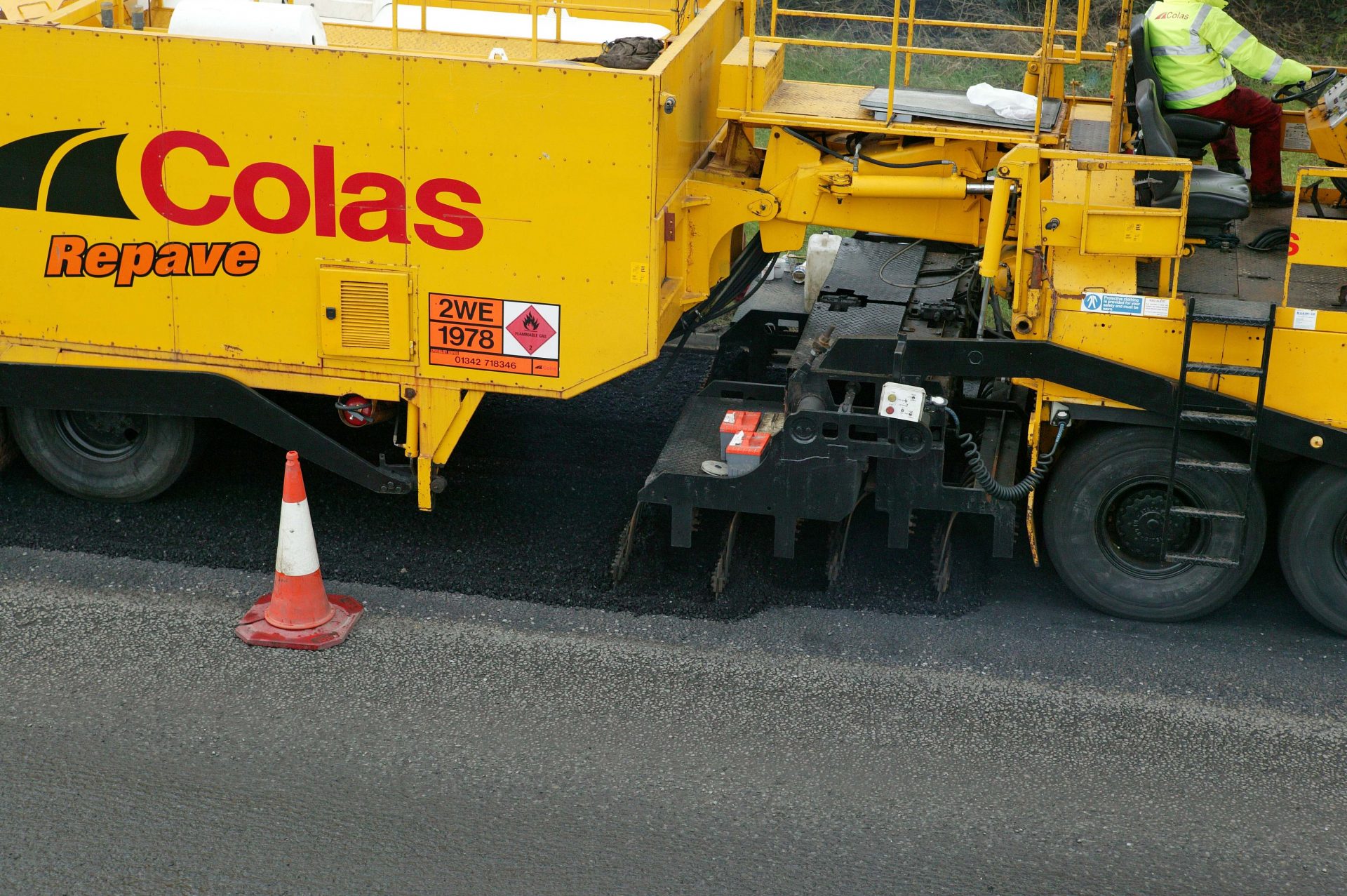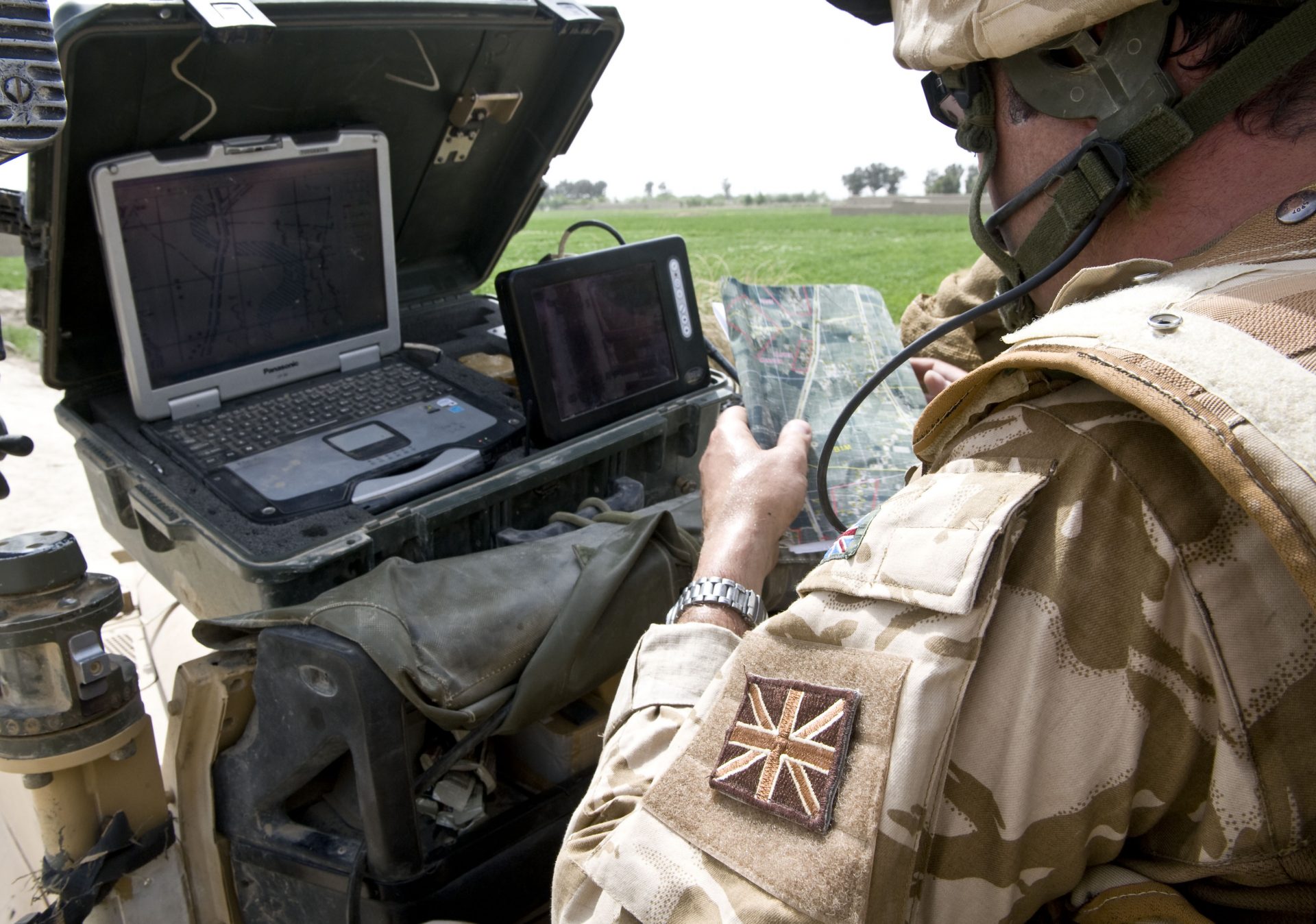Blog Archives
Post navigation

Colas Ltd
The highway maintenance company Colas has deployed Esri’s ArcGIS Online product to help it deliver versatile and mobile GIS capabilities to its field-based personnel. This web-based solution is enabling employees to work more efficiently and make better informed decisions when assessing road damage caused by vehicle accidents.
Colas works closely with Local Authorities and the Highways Agency delivering innovative and intelligent highway maintenance solutions. With over eighty years of expertise, the company has continued to successfully secure and maintain a range of highway term maintenance contracts. Colas was one of the first service providers to successfully manage up to 33% of the UK’s trunk road and motorway network.
In 2004, Colas was the first ever organisation to be appointed a ground-breaking highway PFI contract, for highway and street maintenance in Portsmouth for a period of twenty five years.
Improves efficiency, by allowing employees to view and edit data in the field
Aids decision making by giving field personnel instant access to asset data
Supports better collaboration, while minimising the need for printed maps
The Challenge
Colas is constantly exploring ways to improve its business processes. Having rapidly developed its use of Esri GIS, rolling-out ArcGIS for Server and ArcGIS Explorer, the natural next step was to make GIS more widely available across the company.
“We wanted to bring our GIS strategy up to date and give staff access to Esri GIS over the web on any device, either in the office or on the move,” explained David Piesse, GIS Technician, Colas Limited. “We needed a streamlined approach and one that didn’t need a lot of man hours to get it working or extra programming to create new mobile apps.”
The Solution
ArcGIS Online was selected by Colas to extend the use of GIS across the business and out into the field. Operating seamlessly with its existing Esri investments, the cloud-based system easily increases the reach of Colas’ GIS so it can be used anywhere, by anyone.
“ArcGIS Online is simple to use as the integration with ArcGIS for Server is completely automated. We can view and edit live map data in the field, on iPads or smartphones and don’t need to manually update data when staff return to base,” said Piesse. “Creating new apps for use on mobile devices, for an ad-hoc road survey for example, is also very straightforward and only takes about an hour.”
ArcGIS Online is simple to use as the integration with ArcGIS for Server is completely automated. We can view and edit live map data in the field, on iPads or smartphones and don’t need to manually update data when staff return to base
David Piesse – GIS Technician
The Benefits
The new approach has not only transformed the way mobile teams operate but is also creating more efficient ways of working for office staff too.
A prime example of how it makes life easier for field personnel is when they perform road surveys, prior to any maintenance or resurfacing work. Teams now simply record the highway condition using the ArcGIS app on an iPad, in real-time. This streamlined data collection process has also significantly improved data accuracy, due to fewer steps being involved compared to the previous use of paper maps. Digital photographs are also simply attached to the map at specific locations to help explain any defects.
The Colas teams that respond to road accidents have also had their work practices upgraded by ArcGIS Online. Real-time access to mapping on Windows 7 smartphones means they can instantly see what falls under Colas’ responsibility when assessing highway damage at an incident. Now they have the added confidence they are working with accurate data on boundaries, utilities and other features, which might have an impact on their course of action.
ArcGIS Online also allows office staff to work with GIS in other ways, freeing them from their desktops. Now they can collaborate and share map data on iPads instead, which also eliminates the need to print out paper maps. “ArcGIS Online helps fulfil all of our nonstandard requests for mapping – when a map is needed out on site, for remote working at home, in a depot or at a supplier meeting, for example,” said David.
This has made office-based staff realise GIS is not just about a paper or desktop map but rather a dynamic and interactive resource, as David continued: “Shifting people’s perception of GIS is key to ensuring its true benefits are realised and this is happening through ArcGIS Online. By using tablets or smartphones, boundaries are removed and staff are having their eyes opened to new ways in which GIS can support the business and help them make better decisions.”
Future plans at Colas include using ArcGIS Online to roll-out GIS to every member of its 400 office staff across 22 UK locations, plus the integration of ArcGIS Online into the organisation’s asset management system for enhanced reporting.
“Introducing ArcGIS Online was a natural evolution within our overall GIS strategy,” concluded David. “It’s simultaneously helping to create a raft of more efficient ways of working and innovative highway maintenance services, which help win new contracts.”

Royal Engineers
Esri’s ArcGIS software has been embedded into an engineering planning and control system, used by the Royal Engineers to help it build bridges, manage minefields and arrange demolitions in combat zones. GIS helps teams to complete tasks more quickly and make better decisions.
The Customer
One role of the Royal Engineers (RE) is to assist land based forces achieve their mission objectives, by maximising their mobility, survivability and sustainability using a wide range of specialist support services such as bridge building, mine clearing and demolition.
Improves situational awareness, contributing to better decision making
Enables tasks and resources to be located with precision, saving time
Promotes greater collaboration and sharing of information
The Challenge
Historically, the RE relied on manual, labour-intensive methods (broadly unchanged since the Second World War) that can be slow, resource intensive and prone to errors.
For example, the surveying and siting of a temporary bridge relied on the skills and experience of the RE using measuring equipment and whatever paper-based mapping was available. However, if the surveying and construction teams did not share the same mapping and positional awareness, the bridge could be constructed in the wrong location or to the wrong specification for the conditions.
The RE sought a new approach to planning and tasking that would achieve greater efficiency and increase its capability to respond effectively to operational demands.
The Solution
MAKEFAST is one of a number of BISAs (Battlefield Information System Applications) designed to operate through the developing BOWMAN communications infrastructure, and uses Esri’s Geographic Information Systems (GIS) technology for the mapping component. MAKEFAST has been developed to provide software tools that replicate existing RE processes: a comprehensive engineering planning and control package for combat engineers, supporting mission-critical tasks such as gap crossing, service provision, minefield management and demolition. It assists with planning, designing, resourcing and construction management and will be integrated and interoperable with other information systems within the land component of any operation.
The GIS component enables engineers to locate tasks and resources with precision, aiding deployment. Detailed overlays can be quickly drawn and shared between HQ and operational staff (in raster and vector format), improving situational awareness and informing decision making from a single, shared view of the task.
A detailed asset inventory is an important new capability: each asset has its own icon in MAKEFAST’s sketching tools, and these can be dragged and dropped onto maps, making it quick and intuitive to create scale drawings and geo-referenced overlays. A gap crossing tool is another feature: it is for accurately calculating the correct span, loadings and therefore equipment requirements.
Benefits
The MAKEFAST BISA has been received very positively in trials. For those responsible for tasking, it speeds up the briefing process while ensuring a clear and accurate picture is provided. For those responsible for deployment, it means greater accuracy in the siting of the right assets for the task, with the potential to save valuable time. Key benefits so far include:
Increased business process efficiency
The mapping component complements the task planning and resource management functions within MAKEFAST by providing a common geographic reference at reconnaissance, tasking, and construction stages. The installed asset can also be more efficiently georeferenced on completion, allowing its position to be more quickly and accurately communicated to end users.
Greatly reduced task time
The ability to clearly visualise a task and more easily share this information via BOWMAN, coupled with MAKEFAST’s improved design and resource ordering capability is expected to significantly reduce task time, in some cases by half. This will have a major benefit on agility and resource availability, allowing the Royal Engineers to better keep pace with operational tempo.
More effective information sharing and communication
In line with other BISAs planned to utilise the BOWMAN infrastructure, MAKEFAST is fulfilling its objective of promoting greater collaboration, sharing of common data and processes, and reducing information silos, thus enhancing overall operational efficiency and effectiveness.

Scottish Water
We have successfully transitioned 1200 GIS users to ArcGIS and empowered them to do their jobs well, thanks to the professional and cost-effective training provided by Esri UK.
When Scottish Water decided to migrate to Esri’s ArcGIS from a legacy GIS system, it appointed Esri UK to deliver a suite of on-site and online training courses. This comprehensive and bespoke training programme enabled 1200 GIS users to transition confidently to new business processes and make optimal use of ArcGIS in their jobs.
Bespoke training enables 1200 GIS users to transition smoothly to new enterprise GIS
Professional trainers give employees the skills to do their jobs effectively
eLearning resources provide long term return on training investment
The Challenge
At Scottish Water, geographic information system (GIS) solutions play a pivotal role in helping the company to deliver 1.34 billion litres of drinking water and take away 847 million litres of waste water, day after day. Over 1200 employees use GIS routinely for everything from handling customer enquiries to planning new infrastructure investment. Consequently, when Scottish Water decided to replace its existing GIS with Esri’s ArcGIS enterprise-wide, it recognised the importance of providing high quality training.
“The transition to ArcGIS marked a big step change for the business in the way that it employs GIS and shares data, across a number of business processes,” says Stuart Hill, Business Change Manager at Scottish Water. “It was critical for the business to ensure that every-day users could be confident in using the new technology from day one. At the same time, it was also important for us to ensure that more advanced users in our IT team had the ability to maintain and support our new enterprise GIS platform.”
The Esri UK trainers were very experienced and had a real passion for the product. They delivered what we were looking for within our tight budget
Stuart Hill, Business Change Manager, Scottish Water
The Solution
First, experienced trainers from Esri UK held workshops and worked closely with representatives from the business to gain a clear understanding of users’ requirements. Then, Esri UK developed courses, training manuals and training documentation using the company’s own data and examples of actual business processes, to make the training highly relevant and meaningful for employees.
Esri UK also created different levels of courses for the company’s 381 desktop users and 868 web GIS users, to cater for different requirements. These included a basic course for employees who predominantly just use the ArcGIS web portal to view and search for data on maps; a standard desktop course for employees who need to perform some data analysis and data editing as a part of their roles; and an advanced desktop course for specialist users, which included instruction on data management and the development of the company’s ArcGIS web portal.
Over a four month period, Esri UK delivered 39 separate training courses, at five different locations across Scotland. For each of these courses, Esri UK supplied laptops for all attendees, pre-loaded with all of the ArcGIS software, business data and examples, so Scottish Water did not have the inconvenience or additional cost of having to prepare, setup and use its own IT resources.
In addition to the face-to-face training, Esri UK also developed a portfolio of eLearning resources to allow employees to acquire skills and knowledge of ArcGIS, at a time to suit them, online. As with the face-to-face courses, this web-based training was designed to meet the training requirements of different levels of user and was fully tailored to reflect Scottish Water’s business processes.
Esri UK’s training programme gave our employees the competence and confidence to use ArcGIS to its full potential and do their jobs to their best ability
Stuart Hill, Business Change Manager, Scottish Water
The Benefits
Smooth transition to a new enterprise GIS
Scottish Water’s employees were able to transition more easily to the new ArcGIS, because the training provided by Esri UK was bespoke to Scottish Water and based on the company’s own business data and processes. “Our employees were better able to understand the training and could embed new skills more quickly, because they were working with data that they were already familiar with,” Hill explains.
Improved return on ArcGIS investment
By providing training at different levels, for different categories of users, Esri UK has helped to ensure that all employees can make optimal use of ArcGIS, whether they are handling customer enquiries, managing assets or developing apps. This, in turn, will help the company to maximise the return that it gains from its investment in ArcGIS. “Esri UK’s training programme gave our employees the competence and confidence to use ArcGIS to its full potential and do their jobs to their best ability,” Hill says.
Flexible and inclusive training options for employees
The combination of classroom-based training courses, at five locations, and online eLearning resources gave the company’s 1200 GIS users a choice of ways to receive training, depending on their preferred learning style and situation. The eLearning resources were particularly ideal for employees based in more remote locations, who didn’t find it easy to travel to attend an on-site course, as well as people who prefer to learn at their own pace. As Hill explains, “The different methods of delivering training helped us to ensure that everyone who needed training, had access training.”
Long term benefits from training investment
Scottish Water will continue to gain ongoing benefits from its investment in Esri UK’s training services for many years to come, as it can continue to use the bespoke eLearning resources to train new employees and existing employees who move into new roles that involve using ArcGIS. Employees who attended training courses can also refer back to eLearning resources to reinforce what they learned in the classroom, helping them to continually develop and advance their skills.
Value for money from experienced trainers
All in all, Hill believes that the training services delivered by Esri UK for Scottish Water were highly professional and cost effective. “Esri UK definitely delivered value for money,” he says in conclusion. “The Esri UK trainers were very experienced and had a real passion for the product. They delivered what we were looking for within our tight budget.”

Costain
ArcGIS is a critical enterprise solution that is helping us to deliver exceptional services for our clients and strengthen our position as a leader in the engineering industry.
The engineering solutions company Costain started out with just a single licence for Esri’s ArcGIS Desktop solution. Now, ArcGIS is a pivotal, enterprise system that is increasing employees’ productivity, improving client services and giving the company a strong competitive advantage.
Road inspectors complete 60% more surveys in a week using ArcGIS mobile solutions
An environment team saves around 18 hours a week with an ArcGIS web app
Contact centre staff respond promptly to maintenance requests using ArcGIS Enterprise
The Challenge
For many years, geographic information system (GIS) technology was little used at Costain. The company had a single licence for Esri’s ArcGIS Desktop application and, from time to time, it used subcontractors to create stand-alone GIS applications for specific projects. “We had different approaches for different contracts, with GIS services being commissioned for some and not others,” says Orla McManus, Head of GIS for New Business, at Costain.
As demand for GIS solutions increased, the use of subcontractors became a significant cost for the business. Furthermore, as each GIS application developed had a limited scope, defined by the needs of a specific project, the benefits of using GIS were constrained. Costain therefore decided to expand its use of Esri’s ArcGIS platform internally and use it as a strategic tool to help it deliver industry-leading, technology-driven engineering solutions.
Our extended use of ArcGIS puts us in a stronger position to win new business and deliver exceptional service for our clients in some of the UK’s biggest engineering projects
Orla McManus – Head of GIS – New Business, Costain
The Solution
Costain deployed ArcGIS Enterprise to create a single portal for geospatial information, for the entire organisation, hosted in its UK datacentres. It then developed a series of ArcGIS mobile apps and ArcGIS web apps to provide specific groups of employees with the capabilities they need to access data pertinent to their contracts and perform their jobs.
ArcGIS is currently used by groups of Costain employees including:
– Roads inspectors for managing 150,000 assets on a seven year highways and road maintenance contract
– Environmental teams for carrying out ecology, tree and archaeology surveys along a transportation route
– Contact centre staff for responding to telephone queries, noting asset defects and passing on information to maintenance teams
Costain has also created a ‘Costain on a map’ app to provide all employees with a gateway to the company’s growing reservoirs of geospatial data, as well as other systems, such as HR and Building Information Modelling (BIM). “Today, GIS has overtaken BIM in terms of uptake within the business and has very much become our go-to tool for information,” says Sophie Stouki, Head of GIS for Operations, at Costain.
“The ability of ArcGIS to collate data from many internal and third party sources and make it available to lots of people via a web browser is really powerful,” Stouki adds. “Employees don’t need advanced data skills or training to be able to access and use a wealth of open source and live operational data. We currently have around 1200 ArcGIS users, but this figure is going to explode into the thousands. GIS is going to be a part of pretty much every project going forwards.”
We currently have around 1200 ArcGIS users, but this figure is going to explode into the thousands. GIS is going to be a part of pretty much every project going forwards
Sophie Stouki – Head of GIS – Operations, Costain
The Benefits
Effective data sharing and collaboration
Costain’s enterprise GIS platform has significantly improved data sharing within the organisation and made it possible for employees to access a wide range of data sources on demand, from any location, via interactive web maps. As a result, employees now collaborate more effectively and save time across a wide range of activities. For instance, a team of ten environmental specialists has saved as many as 18 hours a week by using an ArcGIS web portal to gain rapid access to environmental data, reducing both the cost and duration of a key client project.
Increased productivity in the field
The roll-out of mobile ArcGIS apps in the field has led to significant productivity improvements, as employees no longer have to travel back to the office to find out information, print out maps or type up reports. For example, road inspectors working on one of the company’s largest highways management contracts now complete 60% more surveys in a week and provide live asset updates to the control room, rather than submitting reports three days later.
More efficient delivery of services
ArcGIS helps Costain to deliver more efficient services to its clients by making it far easier for employees to identify individual street assets and record information about their condition. Contact centre operatives, for example, have the information they need at their fingertips to identify faulty street lights accurately and can pass on a more precise location to the maintenance teams. Costain can, therefore, affect repairs more promptly and deliver a responsive service for its local authority clients and citizens.
Improved management of large contracts
On long-term highways maintenance contracts the use of ArcGIS helps managers to better understand the extent of required works. They can see, at a glance, which areas of grass and vegetation they are responsible for cutting and ensure verges and hedges covered by the contract are not missed. Equally, they can easily see adopted and private land, as well as third party apparatus, and avoid unnecessary interventions and associated costs.
A commercial advantage in tenders for new business
In a highly competitive marketplace, Costain is now better able to tender for high value new contracts as it uses ArcGIS to help demonstrate its ability to deliver advanced, technology-driven engineering solutions. “Prospective clients increasingly see GIS not as a nice-to-have, but as a definite requirement,” explains McManus. “Our extended use of ArcGIS puts us in a stronger position to win new business and deliver exceptional service for our clients in some of the UK’s biggest engineering projects.”

Cork County Council
When the next exceptional storm is forecast to hit southern Ireland, we will have the near real-time information we need to respond quickly and effectively.
Across Ireland, the frequency and severity of storms is steadily increasing, creating logistical challenges for the local authorities that need to maintain local roads. Cork County Council has used Esri’s ArcGIS Online platform to help it monitor issues on roads during extreme weather events, in near real-time, improve its emergency response and support its public communications.
Emergency teams have a clearer understanding of unfolding events during a severe weather emergency
The council can look back over previous crises to see patterns and identify areas for improvement
The general public and emergency responders have up-to-date information about potential hazards
The Challenge
In October 2017, Storm Ophelia propelled hurricane-strength winds across Ireland, taking the lives of three people and causing substantial damage. Yet extreme weather like this can no longer be assumed to be a rare occurrence. According to some estimates, the frequency of storms and severe rainfall events in winter and autumn in Ireland could increase by up to 30 per cent.
Recognising the risk to its local communities, Cork County Council wanted to improve its ability to monitor and communicate the impact of extreme weather events on its road network. It sought to collate information about roads blocked by flood, fallen trees and heavy snowfall and provide this information in near real-time to council teams, in an easily understood format, so that they could respond more effectively, learn from past events and improve communication to the public.
This historic information enables us to look back at previous severe weather events and learn from the past
Mr Tim Lucey – Chief Executive, Cork County Council
The Solution
The council already used Esri’s ArcGIS web geographic information system (GIS) technology within its organisation and had access to Esri’s ArcGIS Online platform. It also subscribed to a geographic public alert service called MapAlerter, which it used to inform the public on severe weather events and scheduled road closures via text messages to subscribers of the system, as well as posting the information on its Facebook and Twitter accounts. The council decided to leverage its existing investment in both of these services to create a bespoke solution that assists with emergency management.
Now, when field-based council employees observe an issue on a road during exceptional weather, they report it to MapAlerter via text, using road segment codes and message templates. This information is then not only used to generate MapAlerter posts, but is also automatically passed to the ArcGIS Online platform, where it is displayed on an interactive map in near real-time. During storms, teams in the council’s Emergency Incident Room, roads department and other service areas can all view this Severe Weather Map to see a clear picture of the extent of road disruption right across the county. The map refreshes automatically every minute, highlighting new issues as they are reported.
Cork County Council has two views of this information. The first, the ArcGIS Online Severe Weather Map, displays the current situation and can be made available to not only council employees, but also the general public and emergency responders, via Twitter, Facebook, MapAlerter and other news channels. The second version is an ArcGIS Server Portal Map for internal use only, where all the historical data from past events is displayed and can be viewed using the time slider function, so that the council’s staff can look back in time to identify hot spots where the same issues have occurred in sequential extreme weather events.
As ArcGIS Online is a hosted solution, it offers high availability, even in the worst of storms, which is a significant advantage for Cork County Council. “If our offices in Cork are flooded and our in-house IT systems go down, or if senior managers cannot travel into work, we can view the ArcGIS Online map from a temporary emergency centre or from home,” says Judith Vonhof, IS Project Leader at Cork County Council. “In crisis situations, it’s reassuring to know that Esri Ireland has the resources to keep our Severe Weather Map available 24/7.”
With the frequency and severity of storms increasing, councils need to be prepared for dealing with them. This system has certainly assisted with this
Mr Tim Lucey – Chief Executive, Cork County Council
The Benefits
Fast, effective responses during extreme weather events
ArcGIS Online provides a single point of reference, where all council employees can see the same, accurate, up-to-date view of an emergency situation, in a clear visual format, as incidents unfold. As a result, council managers can make faster decisions about how best to allocate resources to clear fallen trees at the earliest opportunity following the storm. Similarly, if managers can see that both major roads to West Cork are flooded, for example, the council’s emergency team can direct field-based teams to the area as a priority to erect signs to warn the public of the potential danger.
Improved long term emergency planning
Cork County Council can use the historical maps and time slider functionality of ArcGIS Server to better understand the impacts of past events and use this insight to prioritise road improvements that could help minimise disruption in the future. “You can never know for certain what the next storm will bring,” says Mr Tim Lucey, Chief Executive of Cork County Council. “But, this historic information enables us to look back at previous severe weather events and learn from the past.”
Better information for the public and emergency services
During major storms, Cork County Council can now play an important role in helping to keep members of the public aware of potential hazards and obstructions on the roads. By directing local citizens to the map with all the latest information, the council can help them make better choices about whether to make non-essential journeys and which routes to take. Emergency responders, such as the fire and ambulance service, can also refer to the map to see the latest status and make better decisions about the best routes to reach people in dire need.
Summing up, Mr Lucey adds, “With the frequency and severity of storms increasing, councils need to be prepared for dealing with them. This system has certainly assisted with this.”

1st (United Kingdom) Division
ArcGIS has allowed us to work more efficiently, in an austere environment, to facilitate enhanced data collection.
Each year the British Army’s 1st (United Kingdom) Division deploys medical units to central Kenya, seeing medical teams working alongside Kenyan Defence Force and Non-Governmental Organisations, to provide primary healthcare, community health education and health outreach clinics in rural locations. In 2017, the Division’s Geo Support team created an innovative mobile survey using off-the-shelf ArcGIS technology, to allow the medical teams to collect patient data more quickly and efficiently.
Faster and easier to implement online and offline surveys
Improved productivity of data collection and better interrogation of results
Enhanced sharing of information with multiple agencies
Innovative use of existing off-the-shelf technology
The Challenge
Exercise ASKARI SERPENT is an annual 1st (UK) Division medical exercise that sees the deployment of a Medical Regiment to rural Kenya. The exercise involves the delivery of health outreach clinics and health education to the local population, alongside Kenyan Governmental and Non-Governmental Organisations.
Every patient consultation is recorded, albeit anonymously. The surveys, in rural locations, were originally conducted using laborious, paper-based methods with standard medical consultation forms. At the end of each day, all the paper forms were handed in and then reported to the main HQ, over the radio. Occasionally the results were also recorded onto spreadsheets but while the actual patient medical forms were accurate, there were often inconsistencies with the data on the spreadsheets. With these ongoing disparities, the spreadsheet results were extremely difficult to analyse and producing a meaningful picture of the survey results was a major challenge.
In 2016 the medical units had support from the Division’s Geo Support team for the first time. The Royal Engineer Geographic Technicians are embedded within 1st (UK) Division and have a long-standing partnership with Esri. They assessed that the methodology using paper-based surveys was an inefficient way of doing things, data collection was incoherent, and that a lot more could be done with the analysis and sharing of results.
One of the key things for me is that we have been able to exploit our training properly and, using off-the-shelf technology, develop an innovative solution that is helping our user community
Sgt D Barrett
The Solution
The Geo Support team had been using Esri’s ArcGIS platform for their GIS (geographical information system) requirements for many years, but the technology had not previously been used for recording medical data in the field. They immediately recognised the potential for improvement with GIS, identifying Survey123 as a suitable tool for patient data capture.
“Historically, our work focused on using geographic data and satellite imagery to create maps and information products to inform decision-making and support operational readiness, where to build a helicopter landing site for example” says LCpl James Smith. “This was a really interesting opportunity for us to show how we could innovate by using off-the-shelf GIS technology for mobile data collection, with more sophisticated analysis.”
First, the team created a patient data survey with Survey123 Connect for ArcGIS. This was shared with the next deploying medical team onto tablets – already available to the medical teams- so they could test the survey in the field running the Survey123 app, and identify any adaptations that needed to be made. The customised survey was then shared and used by all medical technicians in the field, who would record all patient information in an online survey and submit it after each consultation.
Even surveying in remote locations, where there was no phone signal, was possible. Significantly, Survey123 works offline and allows users to save data to the device they are working with, uploading it when an internet connection becomes available.
The Geo Support team also created a simple web interface that allows users – the majority having no GIS skills – to interrogate the results as they come in and check the source by accessing the individual survey forms. This has been a particularly important development as the medical teams’ work includes monitoring for notifiable diseases including Malaria and Yellow fever.
A Story Map was generated to communicate the results, updated daily, and used to brief up to the Commanding Officer to give the senior team a clear view of what was happening on the ground, all using off-the-shelf technology.
“One of the key things for me is that we have been able to exploit our training properly and, using off-the-shelf technology, develop an innovative solution that is helping the everyday community,” adds Sgt Dave Barrett. “ArcGIS has helped us to get much more out of a pretty scarce resource, helping us to deliver value-added support to 1st (UK) Division.”
This is an excellent example of a Junior Leader in the British Army using their initiative and talents to enhance our ability to share information with partners that we work alongside. The Survey123 really hit the mark
Col AG Johnson
The Benefits
Fast and simple to implement
Using the ArcGIS platform, the Geo support team could produce the app with off-the-shelf technology which, for them, meant it was a very low barrier to entry initiative. The medical units already had access to the hardware, ie tablet devices, so the predominant outlay was the minimal time required by the team to develop, then customise the patient briefing form on the mobile app.
Improved productivity of data collection
The medical units can now undertake more patient consultations and collect significantly higher volumes of patient data thanks to the ease of using the Survey 123 app. In 2018 6,000 records were collected using the mobile app, compared to 2,000 paper-based records in 2017. The mobile app also allows teams to work in remote locations with limited internet connectivity; data records are simply uploaded when a mobile signal is available. Timeliness of reporting has also improved, enabling the UK military medical units, working in partnership with the Kenyan Ministry of Health, to provide the Kenyan County Health Ministry with this important civilian primary information.
Improved sharing of information
Thanks to the simplicity of reporting via the web interface the data is available to a wider audience, including government departments, facilitating greater collaboration across multiple agencies. An excel spreadsheet has also been generated which allows users to query the data. Ultimately, this access to more accurate data will help all partners to better understand the medical needs of the local population so that better medical care can be delivered to those who need it.
A Story Map was also created as an internal reporting tool, to share results with Army colleagues. Updated daily, the Story Map includes embedded video and images which gives unequivocal insight into conditions on the ground.

Oil and Gas Authority
Using ArcGIS Online we have created a single gateway to all the information that companies might need to help them operate or invest in the UK’s oil and gas industry
The Oil and Gas Authority is supporting the development of the UK oil and gas industry by publishing authoritative data about the UK’s oil and gas resources via an Open Data Portal powered by Esri’s ArcGIS Hub. New and existing investors now have a single point of access to all the data they might need and can make faster, well-informed decisions about financing new oil or gas explorations.
45,000 unique users visited the Open Data Portal in less than two years
12 weeks of manual data preparation eliminated annually
Clear insight into investment opportunities in the UK oil and gas industry
The Challenge
The Oil and Gas Authority (OGA) exists “to regulate, influence and promote the UK oil and gas industry”, and the dissemination of information is a critical part of all three of these roles. The organisation holds vast amounts of data about the UK’s oil and gas resources, including active and historic exploration and production data, and it wanted to find a way to make all this information more accessible.
In particular, the OGA wanted to provide potential investors with a single point of access to all the data they might need to inform a decision about financing a new oil or gas exploration. John Seabourn, Head of Digital Services at the OGA, explains: “The OGA is committed to revitalising exploration activity in the UK, to discover new oil and gas resources. We wanted to make information more easily available to support oil and gas companies, attract new investment and help develop what is a very important industry in the UK.”
The Oil and Gas Authority’s Open Data Portal gives organisations a clear insight into where the greatest opportunities exist and provides them with the information they need to make decisions about new oil and gas explorations
John Seabourn – Head of Digital Services – Oil and Gas Authority
The Solution
Initially, the OGA thought it would need to build its own open data portal, using data models and hyperlinks. Then, it discovered Esri’s ArcGIS Hub, a hosted and managed solution that is available within ArcGIS Online. “All we needed to do was expose our existing ArcGIS Server to ArcGIS Hub and all the hard work was done for us,” Seabourn says. “It is a very simple, elegant solution that suits all our requirements.”
The organisation called upon Esri UK’s Professional Services group to provide some assistance with the deployment of the solution. Most beneficially, the Esri UK consultants shared their knowledge of ArcGIS Hub and delivered bespoke training for the organisation’s employees to give them the confidence and skills they needed to expand and further develop the portal in the future.
Developed using out-of-the box functionality, the first Open Data Portal was up and running within just six weeks. The OGA continued to add new services over time and completely refreshed the portal about eighteen months after its launch. “One of the real advantages of ArcGIS Online is its flexibility,” says Tanya Knowles, GIS Manager at the OGA. “It is very easy for us to add new data sources and change the presentation of our data in response to customer feedback or short term events, such as licensing rounds on the UK Continental Shelf.”
Oil and gas companies, academics, industry consultancies, government bodies and investors now have a single gateway to a wealth of information and can view the data via online dashboards, web apps, stream it directly into their own systems or download it in a range of formats. “ArcGIS enables us to make a huge variety of data accessible, including information that the industry wouldn’t expect, such as specialist reports and production data in a spatial format,” Knowles observes.
ArcGIS enables us to make a huge variety of data accessible, including information that the industry wouldn’t expect, such as specialist reports and production data in a spatial format
Tanya Knowles – GIS Manager, Oil and Gas Authority
The Benefits
A valuable service used by over 45,000 people
Undoubtedly, the OGA has succeeded in developing an information service that meets the needs of the industry. From October 2016 to July 2018, the organisation accrued over 55 million requests to its ArcGIS Server that powers its Open Data Portal, from 45,000 unique users. Over this same period, the weekly traffic to the server increased by 700%, and visitors began to access five times the number of pages, which demonstrates the growing value of the service. In a single week in May 2018, there were 1.2 million requests to its ArcGIS Server.
Clear insight into investment opportunities
The Open Data Portal is helping the Oil & Gas Authority to promote the UK’s oil and gas industry and attract investment to the UK, by making accurate, pertinent information readily accessible to potential investors. “There are up to 20 billion barrels of oil equivalent still to be recovered from the UK Continental Shelf,” Seabourn says. “The Oil and Gas Authority’s Open Data Portal gives organisations a clear insight into where the greatest opportunities exist and provides them with the information they need to make decisions about new oil and gas explorations.”
Industry-wide time and cost savings
The creation of the Open Data Portal has led to significant time and cost savings, not only for the OGA but for companies right across the industry. At the OGA, a cartographer used to spend one week a month preparing data updates for publication on the organisation’s website; now data updates run automatically, overnight, with no manual intervention. Other companies benefit from being able to access data in precisely the format they need, or stream it directly into their systems, which removes many hours of data preparation and updating.
A single, authoritative source of industry data
Finally, the Open Data Portal helps the OGA to regulate and positively influence companies in the industry, by providing them with a single, authoritative source of data. Everyone can see the same operational picture, which improves understanding and collaboration. Summing up, Seabourn says, “ArcGIS has proved its value. The success of our Open Data Portal has justified more investment in data, technology and digital services.”
Donegal County Council
We can now engage citizens in our planning processes more successfully using Esri’s Crowdsource Reporter and Crowdsource Manager templates
As part of the EU Northern Periphery Arctic Programme funded IMPROVE project on creating better public services, Donegal County Council commissioned Esri Ireland to help it engage with citizens more effectively on planning issues using crowdsourcing technology. Now the council can capture local knowledge and give citizens a stronger voice in the planning process.
Planning Officers make more efficient and better informed decisions about planning applications
Citizens play a greater role in the planning process as their views and knowledge are captured
Esri Ireland delivered the solution in 3 to 4 weeks using ArcGIS Online templates
The Challenge
Like all local authorities, Donegal County Council needs to take into account a huge range of factors when making decisions about planning applications. Much of the information it requires – such as the locations of special areas of conservation and flood risks – is held centrally within the council’s geographic information system (GIS), Esri’s ArcGIS platform. As a result, planning officers use ArcGIS to analyse the locations of proposed developments and identify any potential development conflicts quickly and easily.
The council realised, however, that there was a lot of local knowledge about Donegal that was not accessible via its GIS. Communities, families and individuals had knowledge about certain buildings, fields and even hedgerows that was often very pertinent to planning decisions, but that wasn’t recorded. The council consequently wanted to find a way to capture this ‘micro-knowledge’ within ArcGIS, so that it could be taken into account at an earlier stage in the planning process.
If we have more local information up-front, we can make well-informed decisions more quickly, improving the overall efficiency of our planning process
Daragh McDonough, Information Systems Project Leader – Donegal County Council
The Solution
With funding from the EU Northern Periphery Arctic Programme (NPA) IMPROVE project, Donegal County Council commissioned Esri Ireland to develop a solution for capturing local information from members of the public, making it publically available and incorporating it into the council’s core GIS planning systems. Esri Ireland achieved these goals by using Esri’s ArcGIS Online Crowdsource Reporter and Crowdsource Manager templates to expand the capabilities of the council’s existing ArcGIS platform.
“Esri Ireland brought strong expertise of working with Esri’s ArcGIS Online templates, specifically the Crowdsource Reporter and Crowdsource Manager, and was able to turn the project around for us very quickly,” says Daragh McDonough, Information Systems Project Leader at Donegal County Council. “We also learned a lot from working with Esri Ireland during the project, so we will be able to maintain and develop the solution ourselves in the future.”
After trialling the solution with a focus group of local citizens, Donegal County Council structured its crowdsourcing portal around seven key themes, ranging from the natural environment to transportation issues, with up to 12 different sub-sections underneath each. In this way, the council is able to organise the content it collects and use it effectively within its planning systems.
Now, members of the public can access the solution, named MyDonegalPlace, on the council’s website, put a dot on the map and enter local information on anything from the site of a bird’s nest or the birthplace of a local hero to a traffic black spot. They can upload images and vote or comment on other people’s posts, helping the council to see which issues are most important locally. Council employees use Crowdsource Manager to moderate the content before it is published, making sure that personal details are not revealed.
Esri Ireland has given us a fantastic new way of capturing local information and giving citizens a role in the decision-making process for planning applications
Daragh McDonough, Information Systems Project Leader – Donegal County Council
The Benefits
Improved efficiency in the planning process
Donegal County Council expects to be able to make more informed planning decisions, as it can now take into account concerns and knowledge that local people have, right from the outset. For example, the council anticipates that it will need to issue fewer Further Information Requests, which can delay planning applications by up to 16 weeks. “If we have more local information up-front, we can make well-informed decisions more quickly, improving the overall efficiency of our planning process,” McDonough says.
Time and cost savings for developers
Developers and individuals who submit planning applications can potentially save money and time by using the Crowdsource Reporter to better understand local concerns. If they ensure that these local issues are fully addressed in their initial planning applications, they will avoid the added costs and delays that typically occur when plans are refused and amendments are required.
Greater community engagement in planning
Ultimately, the development of the new crowdsourcing solution benefits communities throughout Donegal, as it allows anyone to engage in the planning process in a structured way. “It gives people a voice,” McDonough says. “Esri Ireland has given us a fantastic new way of capturing local information and giving citizens a role in the decision-making process for planning applications.”
Enhanced public consultations
Looking ahead, Donegal County Council plans to use Crowdsource Reporter during public consultations to give members of the public a greater choice of ways in which to engage in the process. For example, it plans to use its new crowdsourcing solution as part of the upcoming Letterkenny Town Plan Review. “Crowdsource Reporter is a really valuable tool that we can use to engage with local people during public consultations, alongside traditional drop-in clinics and events,” McDonough says. “It will help us to get more people involved in building a shared vision for the future of Letterkenny.”

Field Studies Council
By using a range of ArcGIS tools at our field study centres across the UK, we are helping to advance the use of GIS in the classroom and giving young people the real-life skills to succeed in their futures
Each year over 150,000 secondary school students and their teachers visit centres run by the Field Studies Council (FSC) to learn about the environment, undertake fieldwork and explore new scientific techniques. Since 2014 FSC has been embedding Esri’s ArcGIS platform as a core technology to help students acquire real-world skills, as well as supporting teachers in delivering engaging geography lessons with integrated GIS skills.
Students gain first-hand experience of using GIS in the field
Teachers derive inspiration from best practice use of GIS in education
FSC benefits from the support of Esri UK’s education specialists
The Challenge
Geographic information system (GIS) technology now features prominently in both the GCSE and A level geography specifications, and students studying at both levels need to understand how GIS could be used to collect, visualise, analyse and interpret data. However, the use of GIS in schools is often impeded by teachers’ lack of experience and confidence in using the technology, along with challenges of access to hardware in school.
As an environmental education charity that runs thousands of residential and day courses for geography, geology and biology students and professionals every year, the Field Studies Council (FSC) wanted to take a leadership role in the use of GIS in teaching. Rather than rely on simplistic solutions like Google Earth, it wanted to showcase the use of market leading GIS technology and equip both students and teachers with the skills to succeed.
Using ArcGIS, students spend more time thinking about what their data means and less time manually creating maps and handling data
David Morgan – Education Technology Officer – Field Studies Council
The Solution
There were two primary reasons why FSC selected Esri’s ArcGIS platform. Firstly, the organisation found the software very intuitive to use and felt it would be an easy system for young people and non-technical, teaching staff to become proficient in. Secondly, FSC felt well supported by Esri UK’s team of education specialists, who were on hand to help FSC employees build their capabilities with the solution and develop teaching resources.
FSC now uses a suite of ArcGIS solutions across all nineteen of its centres in England, Wales, Scotland and Northern Ireland. Students start by performing research using data from Esri’s Living Atlas and ArcGIS Online to explore environmental or geographic issues and develop their knowledge of the study area, helping them to plan their investigations. They then use Esri’s Collector for ArcGIS and Survey123 for ArcGIS in the field to collect data via mobile devices and undertake studies on anything from glaciated landscapes and the impacts of flooding to human ‘moods’ in urban areas.
All of the data collected in the field using Collector and Survey123 is instantly uploaded to ArcGIS Online on their return to the classroom, so groups do not waste time processing and copying data. They can then view their data alongside that collected by their peers on interactive maps in ArcGIS Online to identify trends and analyse data. The cloud-based nature of ArcGIS Online means that students and teachers can access their project data from home or school after their residential trip.
ArcGIS connects students to the real world. It shows them that they are developing skills that have an application in a wide range of careers, beyond school and education
David Morgan – Education Technology Officer, Field Studies Council
The Benefits
An enhanced learning experience
Students that attend FSC courses have an enhanced learning experience, because they can analyse the data they have collected in the field as soon as they get back to the centre and combine their own findings with relevant contextual data, on interactive maps, at the push of a button. “Using ArcGIS, students spend more time thinking about what their data means and less time manually creating maps and handling data,” says David Morgan, FSC Education Technology Officer. “That means learners can spend more time tackling higher level questions and ensure they get the most value from their studies.”
A platform for continued learning
As FSC allows students and teachers to continue to access their own data via ArcGIS Online long after the end of residential courses, students are able to build on what they learned. “For lots of our students, the work that they do on a fieldtrip provides the basis of coursework for their A levels” Morgan says. “With ArcGIS, the data they need for their projects is exactly where they left it, and, most importantly, they know how to analyse it with ArcGIS.”
A demonstration of good practice for teachers
During school visits, teachers are themselves often inspired by FSC’s use of ArcGIS. GIS with the FSC is integrated, student led, differentiated for each student’s ability and broad enough to allow students to self-direct in ways which will support their understanding around a topic. Many teachers return to attend professional courses, run by the FSC, aimed specifically at helping teachers to use ArcGIS to support teaching of GCSEs and A levels, as well as Highers and Advanced Highers in Scotland. “When teachers see ArcGIS being used well, they say how can I do that?” Morgan says.
Real-world skills for the future
With access to the latest ArcGIS solutions, students at FSC centres gain experience of using the kinds of GIS tools that professional geographers and ecologists use in their jobs. “ArcGIS connects students to the real world,” observes Morgan. “It shows them that they are developing skills that have an application in a wide range of careers, beyond school and education.”

Strutt & Parker
We can now play a leading role in the development of the British wine industry by using an ArcGIS Online solution to identify the most suitable land for new vineyards.
Land and real-estate agency Strutt & Parker is working with some of the world’s leading wine producers to help expand the production of sparkling wine in the South East of England. Using a solution based on ArcGIS Online called FarmView, it can rapidly identify the best sites for vineyards, taking into account a vast array of factors including soil type, terrain and climate.
Over 1,500% return on investment achieved by Kent office
A four-fold improvement in productivity for viticulture land agents
More successful grape crops due to better selection of land
Our ArcGIS solution has made us far more competitive and profitable, compared to other agencies
Edward Mansel Lewis – Senior Associate Director – Strutt & Parker
The Challenge
Subtle changes in the climate in England, caused by global warming, are creating ideal conditions for the production of sparkling wine. As a result, more and more wine producers are looking to acquire land in South East England to plant vineyards. The government is actively supporting the expansion of the British wine industry and has set a target for the total area of vineyards in the UK to exceed 3,000 hectares by 2020.
The land agency firm Strutt & Parker was commissioned by a major wine grower to identify land in Kent with precisely the right soil type, elevation, aspect weather patterns and slope for optimal grape cultivation. However, there was no single source of data that the organisation could turn to in order to assess the suitability of each available parcel of land. Agents needed to undertake research across multiple websites and data sources, interpret maps at different scales and manually generate reports for the client, which was extremely time consuming.
FarmView not only benefits our clients with an insightful and authoritative appraisal of a site’s value, but it has also significantly improved our own business processes, saving time and money
Nicholas Watson – Head of Land Management in the South East, Strutt & Parker
The Solution
Strutt & Parker discussed its challenges with Mapman, a digital mapping consultancy in Kent. One of Esri UK’s Startup programme partners, Mapman realised immediately that it could use Esri’s ArcGIS Online solution to build an app that would give land agents instant, 24/7 visibility of all of the data they needed, on a single interactive map.
Mapman used ArcGIS Online and authoritative data from the Ordnance Survey, Cranfield University, the Met Office and other open sources to create a viticulture app, which it named FarmView. “I have long experience of using ArcGIS and am very confident in it as a digital mapping platform,” says Pete Wain, Managing Director of Mapman. “It is very easy to deploy new applications and share data, plus it is scalable, resilient and has security built in. I wouldn’t have considered building FarmView with any other GIS system.”
Strutt & Parker jumped at the opportunity to become the first corporate user of FarmView. Using the ArcGIS Online solution, its land agents can select any parcel of land and click on it to see an immediate assessment of its soil, terrain and climate, indicating the land’s suitability for vineyards. Land agents can also apply a search function to see, in an instant, where suitable land exists across a specific region or county.
Significantly, Strutt & Parker can use the location intelligence of FarmView to create data-driven and branded reports, with embedded statistics, to send to clients. The thoroughness of the analysis facilitated by ArcGIS Online, and clarity of FarmView’s reports, makes it very easy for the organisation’s clients to understand the relative merits of different land parcels and make confident decisions about the suitability of the land.
I have long experience of using ArcGIS and am very confident in it as a digital mapping platform
Pete Wain – Managing Director – MapMan
The Benefits
Over 1500% return on investment
Since subscribing to the ArcGIS-based solution from Mapman, Strutt & Parker has been highly successful in winning new clients and orchestrating land sales, particularly in Kent. Edward Mansel Lewis, Senior Associate Director at Strutt & Parker, says, “The cost of FarmView was split equally between the Kent, Essex, Sussex and Surrey offices within our firm. Using billing figures from the Kent team, since the mapping platform was introduced, we calculate that we have made a return of 1,571% on this quarter share of the investment alone.”
“Extraordinary” time savings
If a farmer or landowner calls to discuss selling fields, Strutt & Parker agents can see within just three or four minutes if that particular land parcel is suitable for vines. “We can identify suitable sites in a quarter of the time that we would previously have spent on each project,” says Mansel Lewis. “FarmView allows us to see, in one picture, all of the features that will determine if a site is right for a vineyard or not. The amount of time that we save, as a result of this ArcGIS-based solution, is just extraordinary.”
Improved profitability and competitiveness
Using FarmView, Strutt & Parker has now built up a bank of several thousand acres of land suitable for vineyards, which gives it a massive competitive advantage over other agents, who might have to search for land on a case by case basis. “Our ArcGIS solution has made us far more competitive and profitable, compared to other agencies,” Mansel Lewis says. “After demonstrating our new mapping solution, we were fortunate enough to win a contract with the largest wine producer in the UK.”
Nicholas Watson, Head of Land Management in the South East for Strutt & Parker, adds, “FarmView not only benefits our clients with an insightful and authoritative appraisal of a site’s value, but it has also significantly improved our own business processes, saving time and money. FarmView is helping to further establish Strutt & Parker as the UK’s leading viticulture consultancy service.”
More successful wine production in the UK
Ultimately, it is Strutt & Parker’s clients who will benefit most, as they will purchase precisely the right kind of land to ensure their success. Mansel Lewis observes, “Our clients have been delighted with the sites that we have found for them using our new mapping platform. Over the course of the next few years, many new vineyards will appear throughout the Kent countryside and you can be sure that the majority of them will have been identified, in the first instance, using the ArcGIS capabilities in FarmView.”


